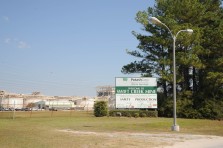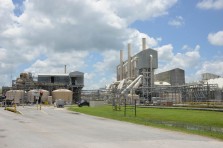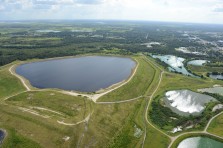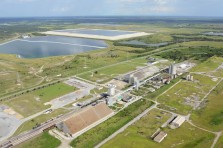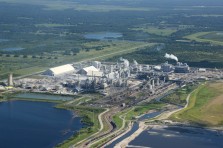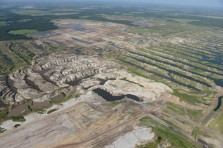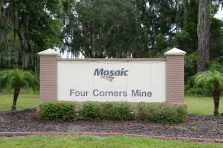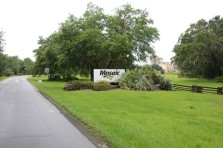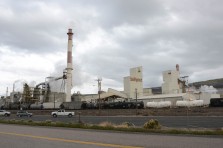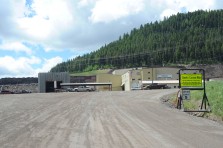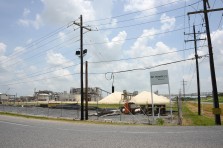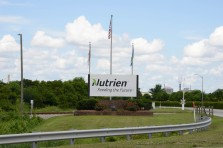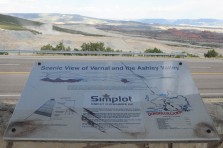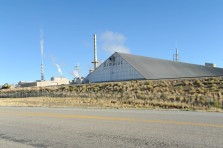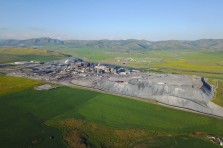Search Results: phosphate
View search results on mapIn addition to its large phosphate mines and plants in Idaho and Wyoming, Simplot operates two small fertilizer plants in the midst of agricultural production in the central valley of California. One plant is at Helm, in the southern end of the valley, which primarily provides ammonium nitrate fertilizer to local agricultural suppliers.
The eastern portion of Nutrien’s phosphate operations in northern Florida surround the White Springs Suwanee River Chemical Plant. The company uses large draglines to remove overburden and dig out the ore, which is sent by slurry pipes to screening and sorting plants, then to production plants where sulfuric acid turns it into phosphoric acid and then into dry phosphate fertilizer products.
One of two major phosphate mines and processing plants in northern Florida, both of which are owned by Nutrien. Though it is more prolific in its production of nitrogen and potash fertilizer products, Nutrien is the second largest phosphate fertilizer production company in the USA, after Mosaic (which dominates production in the massive phosphate mining district east of Tampa).
Mosaic’s Plant City Plant is a bit of an outlier, located by itself north of the rest of the Bone Valley phosphate mines and plants. Since 1965 it has been operated by CF Industries, until it was purchased by Mosaic in 2014. At the end of 2017, after it had produced more than a million tons of processed phosphates and more than half a million tons of phosphoric acid that year, Mosaic announced it was idling the plant for at least a year.
Mosaic’s Tampa Marine Terminal is a storage and shipping facility at the Port of Tampa Bay, used for the export of DAP and MAP, the two primary phosphate fertilizers it produces at its three active central Florida plants, the largest single source of agricultural phosphates in the country. From here the material is shipped by barge around the Gulf Coast, and up the Mississippi to the corn belt and other agricultural areas.
Mosaic uses facilities at the port to receive and store the large amounts of anhydrous ammonia it needs to make phosphoric acid and other products at its production plants. One of these is the Hookers Point Terminal, acquired from CF Industries, with a 38,500-ton ammonia storage tank and a deep water dock. The terminal is connected to a 75-mile underground pipeline system that delivers ammonia to the Riverside Plant, and to the other plants in the Bone Valley.
Phosphate mining stops a few miles east of Tampa Bay and the City of Tampa, but the handling and processing of phosphates occurs around the shore, especially at Mosaic’s Riverview Facility on Tampa Bay. The plant is similar to the two operating in the Bone Valley, a few miles east, and every year produces 800,000 tons of phosphoric acid and 1.6 million tons of processed phosphate from phosphate rock extracted in the valley.
The largest phosphate production region in the USA is the Bone Valley, of central Florida, and the historic center is the town of Mulberry, thirty miles east of Tampa, where mining companies have supported the creation of a phosphate mining museum. The galleries are inside old railroad cars, and have colorful displays about the industry.
Phosphate ore processed at beneficiation plants at the mine sites in the area is moved by rail and pipeline to production plants, one of which is Mosaic’s Bartow facility. The initial material produced at Mosaic’s plants is phosphoric acid, which is created by combining processed phosphate rock with sulfuric acid. Sulfur for creating sulfuric acid comes to the plants by rail or truck from oil refineries, where it is an abundant byproduct.
The former Royster Mine is another former Bone Valley phosphate mine site that is being maintained and partially redeveloped. It is immediately adjacent to the town of Mulberry.
The Bonnie Mine and Plant was a major phosphate site closed in 1999, and is now primarily an environmental monitoring location for the former plant site and waste ponds. Mosaic has leased parts of the old plant site to other companies to use as a storage terminal for bulk materials associated with mining and fertilizer activity.
Mosaic’s New Wales Plant, near the town of Lithia, is the larger of two fertilizer production plants currently operating in the Bone Valley, producing nearly 3 million tons of processed phosphates, and 1.4 million tons of phosphoric acid per year. When phosphate rich ore is mixed with sulfuric acid to make phosphoric acid, it produces phosphogypsum as a byproduct, which is piled high at these plants in a waste mound known as a gypstack.
Mosaic shut down its South Pierce Plant in 2006. Like the others in the area, it produced phosphoric acid, and remains as a potential resource, to reopen or use for parts, and as a remediation and environmental monitoring site, for decades to come. Bone Valley has dozens of permanently closed phosphate operations, many of which are part of Mosaic’s assets and responsibility.
Mosaic’s Lonesome Mine has been closed for a while, with active mining moving south and east to the Four Corners Mine. The landscape remains churned up in the mining areas of Fort Lonesome. Former phosphate mines can be found westward towards Tampa, with increasing amounts redeveloped into housing areas.
Mosaic’s Four Corners Mine is currently the largest of the active phosphate mines in the Bone Valley. It produces around 6.5 million tons of phosphate rock (out of a total of 15 million tons produced by the company globally). The mine covers 12,000 acres, and employs around 500 people. Mosaic has around 20 draglines in the area, and is using 8 of them at the Four Corners mine. The company says they are the largest earth-moving machines on the planet.
Mosaic’s South Fort Meade Mine is currently the second largest of Mosiac’s mines in the Bone Valley, producing around 4.5 million tons of phosphate rock per year. The first step in the mining process is to dig trenches and berms around the immediate area to be mined, so that some of the groundwater drains into the perimeter ditch, keeping the mining area from becoming more of a mud puddle than it already is.
Mosaic’s South Pasture Mine is the third largest of its four active mines in the Bone Valley, producing around 2.8 million tons per year. It is one of a few phosphate mines and plants that Mosaic acquired from CF Industries in 2014, when CF sold its phosphate and potash facilities, to focus on nitrogen.
The fourth active Bone Valley mine, Mosaic’s Wingate Creek Mine, produces around 1.4 million tons of phosphate rock per year. Unlike the others, the Wingate mine has been allowed to flood, and Mosaic uses dredges to remove overburden and mine the ore. Mosaic owns almost 300,000 acres in the valley, and leases the rest of what it needs.
Next to the site of the former FMC plant in Pocatello is the Don Plant, a large functioning phosphate plant operated by Simplot, with a growing black gypstack behind it. The plant has been operating since 1944, when it was the first fertilizer production facility built by the J.R. Simplot company. Much larger now, it produces more than a million tons a year of phosphate fertilizers, feed phosphates, and industrial products, and employs around 350 people.
The Blackfoot Bridge Mine is a recently opened mine in the Permian-age sea bed deposit known as the Phosphoria Formation, in southeastern Idaho. While not as large as the phosphate operations in Florida, more than thirty mines have been worked here over the last century, and today there are a half dozen or so active mines. Blackfoot Bridge was opened by Monsanto, which has mined the area for many years in order to supply its phosphate plant in Soda Springs.
The Smoky Canyon Mine, in southeast Idaho, next to the border of Wyoming, supplies Simplot’s Don Plant in Pocatello with the 1.7 million tons of phosphate ore it consumes annually, to make phosphate fertilizers. The mine was developed in the mid-1980s and has a beneficiation plant on site, which refines and grinds the ore into a powder.
The Uncle Sam facility was originally owned by Freeport Chemical Co., and then by IMC Global, when that company was merged with Cargill’s crop nutrition division to form Mosaic in 2004. Like other phosphate fertilizer production sites, the Uncle Sam plant has a phosphogypsum stack, more than a square mile in size, behind the plant.
The Mosaic Company’s Faustina Plant in Louisiana is one of the largest ammonia plants in the country. It produces ammonia for ammonium phosphate fertilizers (the P of NPK), and is fed by a stream of phosphoric acid which comes to it, via pipeline, from another Mosaic plant across the river. Mosaic’s Faustina Plant is next to CF’s Nitrogen Donaldsonville Complex, the largest production site for nitrogen in the USA.
A few companies dominate the nitrogen fertilizer production industry in the USA, but none more than CF Industries. Though the company has several plants around the country, CF’s Nitrogen Production Complex in Donaldsonville, Louisiana, is by far the largest nitrogen plant in the USA.
When Nutrien came into existence in 2018, taking over the assets of PotashCorp, Nutrien acquired this combined phosphate and nitrogen fertilizer complex in Geismar, Louisiana. It is located in a chemical complex on the Mississippi River, sharing the site with an Innophos phosphate chemical plant, Honeywell Specialty Materials, and Nova Chemicals, with a phosphorous gypstack at the back of the complex.
Located a few miles up the road from Mosaic’s massive phosphate mine and plant is Intrepid’s West Mine facility. Intrepid, based in Denver, is the only US company dedicated solely to producing potash in the USA, and produces more than anyone else, from two mines in New Mexico and two in Utah. The West Mine, opened in 1931 by the American Potash Company, was the first potash mine in the region.
Nutrien is the new owner of PotashCorp’s phosphate mine and plant in Aurora, North Carolina. Not as vast as the company’s northern Florida site, the operation here, measuring 6 miles by 6 miles, is large enough to be called the largest integrated phosphate mining and chemical plant in the nation, since it has just one plant, surrounded by its mines and waste ponds and piles.
The phosphate ore mined here, north of Vernal, Utah, goes to the JR Simplot Rock Springs Wyoming Plant via a pressurized slurry pipeline 96 miles long. The mine was originally developed by the San Francisco Chemical Company in 1960. It was purchased by Chevron in 1981, which built the slurry pipeline and the Rock Springs plant around 1985.
JR Simplot operates this facility outside of Rock Springs, Wyoming, where the company makes monoammonium phosphate fertilizer, as well as phosphoric acid. The Rock Springs plant was built by Chevron in the mid-1980s, and was taken over by Simplot in 2003. The company recently built a $300 million ammonia plant at the site, which supplies the company’s largest phosphate facility, the Don Plant in Pocatello, with ammonia too.
Monsanto’s Phosphate Plant has been operating since the 1950s, and is a functioning superfund site, producing elemental phosphates used for foods, chemicals, fertilizers, and the company’s signature herbicide, Roundup. Monsanto, based in St. Louis, is one of the largest and longest-lasting agrochemical companies in the USA, notorious in more recent times for genetically engineering crops controlled by its branded herbicides.


